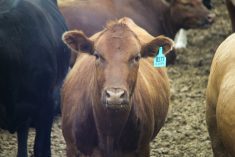Grazing leases are about to change for the first time since 1994 after years of work by Alberta Beef Producers and the seven grazing lease associations in the province.
The quarter-century-old system could have attracted potential tariffs on Canadian cattle, so the changes were necessary, said Rich Smith, executive director of Alberta Beef Producers.

“The current system of rental rates that is in place right now is totally outdated and based on assumptions that are not valid anymore,” he said. “There are concerns about how they have been calculated.
“Over 10 years ago, we started to look at a better system. The fear is that the current system would leave us vulnerable to a trade action. It’s a countervail. It would be identified as a subsidy.”
The United Conservative government introduced Bill 16 — the Public Lands Modernization Amendment Act — last month. It will increase the annual fees a rancher pays for cattle, sheep or horses grazing on Crown land.
The amount of fees collected has been frozen at $2.9 million for 25 years, and the formula used to calculate them was developed in the 1960s. There are currently 6,500 grazing leases in the province, covering more than six million acres of public land.
Read Also

Farming Smarter receives financial boost from Alberta government for potato research
Farming Smarter near Lethbridge got a boost to its research equipment, thanks to the Alberta government’s increase in funding for research associations.
No other input costs have been frozen for over 25 years, noted Smith.
In 2014, a group of grazing associations in the province began working with Alberta Environment and Parks staff and consultants MNP to come up with a framework that would work.
“It’s responsive to market conditions, so rental rates go up if the prices go up,” said Smith. “It’s not going to bounce around from year to year. Over the years, if prices go up, then rents will go up and if prices go down, then rates will go down.”
In 2017, every grazing leaseholder got a letter outlining the proposed new rental program.
“There was good support for it from producers,” said Smith.
All seven grazing lease associations in the province support the proposal. They were not successful in persuading the former NDP government to implement the new rental rates, but found quick backing from the new government.
New regulations will have to be written once the bill passes, but the broad outlines are that fee increases will be phased in over five years (starting in January), will have a flat rate assignment fee of $3,150, and the formula for determining the fee hikes will take into account the nature and location of the land (fees will generally be higher in the south than in the north).
The fee hikes won’t be astronomical, and will result in an increase of a few dollars per animal unit month, said Smith.
“What I’ve said to people is that the increase in rental rates will be far less than countervail trade action — by a huge margin,” he said.
“We think this gives a good balance. It is responsive to market conditions. Leaseholders will pay more when markets are up. That’s fair and gives a fair return to the people of Alberta for their land.”
The situation in Alberta is in sharp contrast to one in Manitoba, where proposed grazing lease changes have created an uproar. The proposed new system in Manitoba would, among other things, see an old points system replaced by an open auction, reduce lease length from 50 years to 15 or less, and introduce a ‘market-based’ rent formula, among other changes. Producers in the province — some of whom rely on leases for nearly all of their grazing land — decried the lack of consultation, saying the changes would greatly reduce the value of their operations and make it nearly impossible for young producers to get started.
But the changes here were enthusiastically welcomed by the Alberta Grazing Leaseholders Association.
“We started this conversation in the late 1990s when the government first began to freeze rental rates,” association chair Kyle Forbes said in a news release.
“As you could imagine, we are so happy and relieved to see this proposed modernization finally move to the point of legislative change necessary for implementation.
“The proposed bill represents unparalleled industry and province-wide collaboration between all the grazing disposition stakeholder groups.”
Under the new legislation, a range sustainability fund will be created, funded by 30 per cent of grazing rental revenue in excess of $2.5 million. The base amount and the other 70 per cent will go into the province’s general revenue accounts.
The proposed lease transfer rules are also being praised. The new system will reduce the paperwork and the cost, said Smith.
“If the legislation goes through this fall, we’re hoping we should have everything in place by the grazing season next year,” he said. “That is our hope.”
– With staff files
















